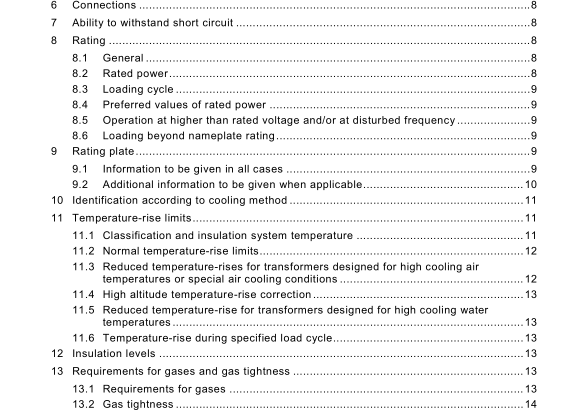IEC 60076-15:2008 pdf download – Power transformers – Part 15: Gas-filled power transformers
o) lnsulation system temperature for each winding (for multi-winding transformers,the
insulation system temperature of each winding should be given).
p) Temperature-rise limits of windings (only in the case of specifying limits other than thelimits in Table 2).
q) Kind of insulating gas.
r) Rated gas pressure (in MPa-gauge).
s) Guaranteed minimum gas pressure (in MPa-gauge).
t)Vacuum withstand capability of the tank.
u) Total mass.
v) Mass of gas.
w) Transportation mass (for transformers exceeding 5 t total mass).x) Untanking mass (for transformers exceeding 5 t total mass).
y) Insulation levels (the rated withstand voltages for all windings shall appear on the rating
plate.The principles of the standard notation are illustrated in IEC 60076-3.).
aa)lf the transformer has more than one set of ratings,depending upon different connections
of windings which have been specially allowed for in the design,the additional ratingsshall all be given on the rating plate, or’separate rating plates shall be fitted for each set.9.3 Additional information to be given when applicable
a) For transformers having one or more windings with ‘highest voltage for equipment’umequal to or above 3,6 kv:
– short notation of insulation levels (withstand voltages) as described in Clause 3 of
lEC 60076-3.
b) For transformers having a tapped winding, particulars about the tappings are as follows:- for transformers having a tapping range not exceeding ±5 %: tapping voltages on the
tapped winding for all tappings.This applies in particular to distribution transformers;for transformers having a tapping range exceeding t5 %: a table stating tappingvoltage, tapping current and tapping power for all tappings. In addition the short-circuitimpedance values for the principal tapping and at least the extreme tappings shall begiven, preferably in ohms per phase referred to a specific winding.
c)Temperature rises of top gas and windings (if not normal values). When a transformer is
specified for installation at high altitude, this shall be indicated, together with informationon either the reduced temperature-rise figures valid under normal ambient conditions,orthe reduced loading which will result in normal temperature-rise at the high altitude(standard transformer with normal cooling capacity).
d) Connection diagram (in cases where the connection symbol will not give complete
information regarding the internal connections). lf the connections can be changed insidethe transformer,this shall be indicated on a separate plate or with duplicate rating plates.The connection fitted at the works shall be indicated.
ln addition to the main rating plate with the information listed above, the transformer shall alsocarry plates with identification and characteristics of auxiliary equipment according to international standards for such components (bushings, tap-changer, current transformers, special cooling equipment).
10 Identification according to cooling method Transformers shall be identified according to the cooling method employed. For gas-filled transformers, this identification is expressed by a four-letter code as described below.
First letter: internal cooling medium in contact with the winding: G insulating gas; Second letter: circulation mechanism for internal cooling medium: N natural/thermosiphon flow through cooling equipment and in windings; F forced circulation through cooling equipment, thermosiphon flow in windings; D forced circulation through cooling equipment, directed from the cooling equipment into at least the main windings. Third letter: external cooling medium: A air; W water.
Fourth letter: circulation mechanism for external cooling medium: N natural convection; F forced circulation (fans, air blowers, water pumps). A transformer may be specified with alternative cooling methods. The specification and the rating plate shall then carry information about the power figures at which the transformer fulfils the temperature-rise limitations when these alternatives apply, see n) of Subclause9.2.
The alternatives are conventionally listed in rising order of cooling capacity. EXAMPLE GNAN/GDAF. The transformer has cooling equipment with blowers and fans but is also specified with a reduced power-carrying under natural cooling. NOTE The percentage of natural cooling capacity to forced cooling capacity of gas-filled transformers is smaller than that of oil-immersed transformers. It is not difficult generally in oil-immersed transformers to achieve ONAN capacity as 50 % of the OFAF or ODAF capacity.
But in gas-filled transformers, it is sometimes difficult and not economical to achieve GNAN capacity as 50 % of the GDAF capacity. It is recommended for the purchaser to consult with the manufacturer about natural cooling capacity to forced cooling capacity.
11 Temperature-rise limits
11 .1 Classification and insulation system temperature
Transformers are classified by the insulation systems shown in Table 1 . The maximum temperature occurring in any part of the winding shall not exceed the insulation system temperature in Table 1 continuously. An approximate value for practical purposes of hot-spot temperature can be calculated by using the concept of Annex B.
